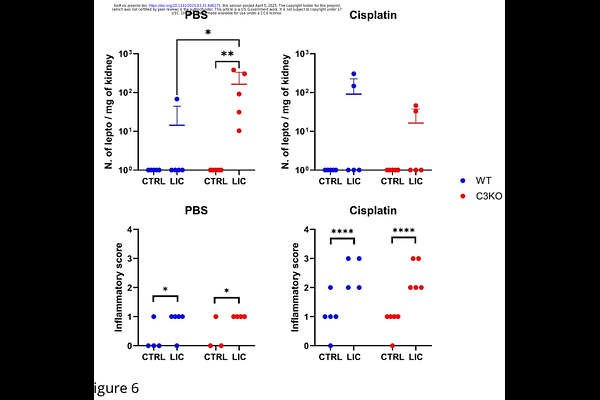Complement C3 Deficiency Enhances Renal Leptospiral Load and Inflammation While Impairing T Cell Differentiation During Chronic Leptospira interrogans Infection

Complement C3 Deficiency Enhances Renal Leptospiral Load and Inflammation While Impairing T Cell Differentiation During Chronic Leptospira interrogans Infection
Midon, L. M.; Duarte Neto, A. N.; Goncalves, A. M. M.; Henemann, M. B.; Kundu, S.; Gomes-Solecki, M.; Isaac, L.
AbstractLeptospirosis is a neglected zoonotic disease caused by pathogenic Leptospira spp., affecting an estimated of one million people annually and resulting in approximately 60,000 fatalities. The disease can lead to hepatic, renal, and pulmonary dysfunctions and may contribute to the development of chronic kidney disease. The Complement System plays a crucial role in eliminating bacteria by generating opsonins, anaphylotoxins, that degranulate mastocytes and basophils, and attract immune cells to the infection site, among other important functions. This study aimed to investigate the role of C3, the central protein of the Complement System, in vivo during chronic infection of L interrogans serovar Copenhageni strain FIOCRUZ L1-130 (LIC). C57BL/6 wild-type (WT) and C3 knockout (C3KO) mice were infected with 108 LIC and monitored at 15, 30, 60, 90 and 180 days post-infection (d.p.i.). LIC-infected C3KO mice exhibited a significantly higher leptospiral load in the kidneys compared to WT counterparts. Both groups showed local inflammation at 15 and 30 d.p.i., but only C3KO LIC-infected mice had a higher number of Leptospira DNA copies at 30 d.p.i. At the same time point, C3KO LIC-infected mice developed a larger fibrotic area than WT mice. Interestingly, independent of C3, mice pre-treated with a nephrotoxic drug increased the renal inflammatory response; however, this pretreatment did not affect the local leptospiral load in infected mice. Additionally, levels of specific IgG2b and IgG3 antibodies were significantly higher in LIC-infected C3KO mice compared to WT mice. Proteomic analysis showed lower levels of C5/C5a in WT and C3KO LIC-infected mice, as well as in C3KO control mice. M-CSF and SDF-1 cytokine levels were reduced in both LIC-infected groups. Furthermore, naive T lymphocytes count (both CD4+ and CD8+) were higher in LIC-infected C3KO mice, whereas effector CD8+ T lymphocyte numbers declined during LIC infection - a phenomenon more pronounced in C3KO mice. Overall, this study demonstrates that during LIC infection, the absence of C3 does not affect mouse survival but leads to increased renal leptospiral load and fibrosis. Additionally, it highlights the crucial role of C3 in supporting the maturation and differentiation of T lymphocytes into pre-effector cells, underscoring its importance as a key link between the innate and adaptive immune responses in leptospirosis.